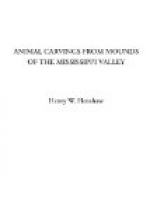The identification of this sculpture as a toucan was doubtless due less to any resemblance it bears to that bird than to another circumstance connected with it of a rather fanciful nature. As in the case of several others, the bird is represented in the act of feeding, upon what it would be difficult to say. Certainly the four etchings across the base of the pipe bear little resemblance to the human hand. Had they been intended for fingers they would hardly have been made to extend over the side of the pipe, an impossible position unless the back of the hand be uppermost. Yet it was probably just this fancied resemblance to a hand, out of which the bird is supposed to be feeding, that led to the suggestion of the toucan. For, say Squier and Davis, p. 266:
In those districts (i.e., Guiana and Brazil) the toucan was almost the only bird the aborigines attempted to domesticate. The fact that it is represented receiving its food from a human hand would, under these circumstances, favor the conclusion that the sculpture was designed to represent the toucan.
Rather a slender thread one would think upon which to hang a theory so far-reaching in its consequences.
Nor was it necessary to go as far as Guiana and Brazil to find instances of the domestication of wild fowl by aborigines. Among our North American Indians it was a by no means uncommon practice to capture and tame birds. Roger Williams, for instance, speaks of the New England Indians keeping tame hawks about their dwellings “to keep the little birds from their corn.” (Williams’s Key into the Language of America, 1643, p. 220.) The Zunis and other Pueblo Indians keep, and have kept from time immemorial, great numbers of eagles and hawks of every obtainable species, as also turkies, for the sake of the feathers. The Dakotas and other western tribes keep eagles for the same purpose. They also tame crows, which are fed from the hand, as well as hawks and magpies. A case nearer in point is a reference in Lawson to the Congarees of North Carolina. He says, “they are kind and affable, and tame the cranes and storks of their savannas.” (Lawson’s History of Carolina, p. 51.) And again (p. 53) “these Congarees have an abundance of storks and cranes in their savannas. They take them before they can fly, and breed them as tame and familiar as a dung-hill fowl. They had a tame crane at one of these cabins that was scarcely less than six feet in height.”
So that even if the bird, as has been assumed by many writers, be feeding from a human hand, of which fact there is no sufficient evidence, we are by no means on this account driven to the conclusion, as appears to have been believed, that the sculpture could be no other than a toucan.




